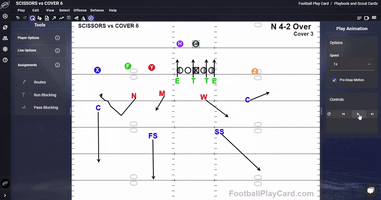Why Scissors Devastates Unprepared Defenses Before we get tactical, here’s what makes the Scissors...
Defending the Mesh Concept: Shutting Down Football's Reliable Pass
What Is the Mesh Concept?
The Mesh Concept is a horizontal crossing route combination that creates natural picks and rubs to generate consistent separation. Two receivers run shallow crossing routes at the same depth, "meshing" together around 4-6 yards downfield before continuing their routes to opposite sides of the field.
Route Breakdown:
✅ Mesh Routes – Two receivers run shallow crossing patterns at identical depths (typically 4-6 yards)
✅ Rub Action – The crossing receivers create natural picks that force defenders to navigate traffic
✅ Clearance Routes – Additional receivers run vertical or comeback routes to occupy deep coverage
✅ The "Mesh Point" – Where the two crossing routes intersect, creating maximum defensive confusion
This concept has become a staple of modern offenses because it virtually guarantees open receivers against both man and zone coverage.

Why the Mesh Concept Is So Difficult to Defend
Exploits Coverage Gaps – Creates natural holes in zone coverage while forcing man defenders through traffic
Generates Natural Picks – Crossing routes create legal rubs that spring receivers open
High Completion Rate – Short, horizontal routes with built-in separation mechanisms
YAC Potential – Open receivers in space can turn short completions into big gains
Coverage Confusion – Forces defenders to communicate and navigate picks simultaneously
How to Defend the Mesh Concept
🛡️ Man Coverage Adjustments
Banjo Coverage – Have defenders "trade" receivers at the mesh point instead of fighting through traffic
Bracket the Mesh – Use a linebacker or safety to sit on the mesh point and jam both receivers
Jam at the Line – Disrupt timing by pressing receivers and forcing them off their routes
Trail Technique – Have defenders stay behind their man and avoid the pick altogether
🛡️ Zone Coverage Solutions
Pattern Matching – Treat crossing routes like "verticals" and match them with specific defenders
Robber Coverage – Drop a linebacker into the mesh window to eliminate throwing lanes
Cover 6 Concept – Combination coverage that puts a defender directly over the mesh area
Aggressive Underneath – Bring safeties down to eliminate the short crossing game
🛡️ Pressure Packages
Quick Game Rush – Four-man rush designed to get home before mesh routes develop
A-Gap Pressure – Interior pressure to force quick throws and disrupt timing
Delayed Blitz – Send a linebacker after the mesh develops to eliminate escape routes
Edge Contain – Keep quarterbacks in the pocket to limit mobility and extend plays
.gif?width=800&height=413&name=2025-05-%2023%20-%20BLOG%20-%20Mesh%20Defense%20-%20Play%20Diagram%202%20%20(1).gif)
Defending Mesh at Each Level
🏈 Pro Football: Advanced Pattern Recognition
Pro defenses use film study and communication to identify mesh concepts pre-snap, employing sophisticated bracket coverage and pattern-matching techniques.
🏈 College Football: Aggressive Underneath Coverage
College defenses often use rover safeties and nickel defenders to aggressively attack the mesh point and eliminate easy completions.
🏈 High School Football: Simple Solutions
High school teams focus on basic banjo coverage and linebacker drops to take away the mesh without over-complicating assignments.
🏈 Youth Football: Teach Fundamentals
Youth coaches emphasize proper tackling in space and communication when defending crossing routes.
Key Coaching Points for Defending Mesh
Step 1: Teach defenders to identify mesh concepts in film study and practice recognition drills
Step 2: Install banjo coverage rules and practice trading receivers at the mesh point
Step 3: Drill communication between defenders to avoid confusion and blown assignments
Step 4: Practice tackling in space since mesh often creates YAC opportunities
Step 5: Develop pressure packages that disrupt timing without leaving big gaps in coverage
Common Mistakes When Defending Mesh
Fighting Through Picks – Defenders getting tangled up instead of using proper technique
Poor Communication – Failing to call out crossers and coordinate coverage adjustments
Overpursuing – Linebackers and safeties running past plays instead of staying disciplined
Neglecting YAC – Allowing open tackles to become big gains through poor positioning
Late Recognition – Not identifying mesh concepts until routes are already developing
Advanced Mesh Variations to Prepare For
Smash-Mesh – Combining mesh with speed-out routes to create horizontal stretches
Mesh-Wheel – Adding running back wheel routes to create vertical conflicts
Trips Mesh – Running mesh from three-receiver formations with additional clearance routes
Motion Mesh – Using pre-snap motion to create leverage and confusion
RPO Mesh – Combining mesh with run-pass options to stress box defenders
Final Thoughts: Keys to Stopping the Mesh
Successfully defending the mesh concept requires discipline, communication, and proper technique. Teams that master banjo coverage, pattern recognition, and aggressive underneath play can neutralize one of football's most reliable passing concepts.
The key is preparation – drilling these concepts in practice and ensuring all defenders understand their roles when mesh routes develop.
💬 How does your team defend the mesh concept? Share your defensive strategies and techniques below!
Next Steps
📌 Want to diagram and analyze mesh defensive concepts like a pro?
Start using Football Play Card today to create defensive game plans and study offensive tendencies!
🔥 Start your trial now at FootballPlayCard.com!
Tags: Defensive Strategy, Football Defense, Pass Coverage, Mesh Concept, Pattern Recognition, Defensive Coaching




